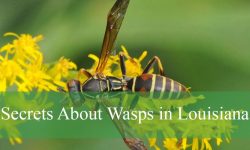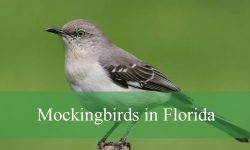The caterpillars of Minnesota range from tiny masters of disguise tucked among leaves to colorful species that stand out in nature. These insects represent the early life stages of both butterflies and moths, making them an essential part of the state’s ecosystems.
Caterpillars in Minnesota can be found in woodlands, meadows, gardens, and wetlands, feeding on everything from milkweed to hackberry trees. Each species has its own unique characteristics, such as striking patterns, defensive hairs, or mimicry that helps them avoid predators.
Whether you are a nature enthusiast, a gardener, or simply curious about the wildlife around you, learning to identify Minnesota’s caterpillars can deepen your appreciation of the state’s biodiversity. This guide introduces 20 types of caterpillars you might encounter, complete with their features, behaviors, and habitats.
Most Common Caterpillars Found in Minnesota
Monarch Caterpillar (Danaus plexippus)
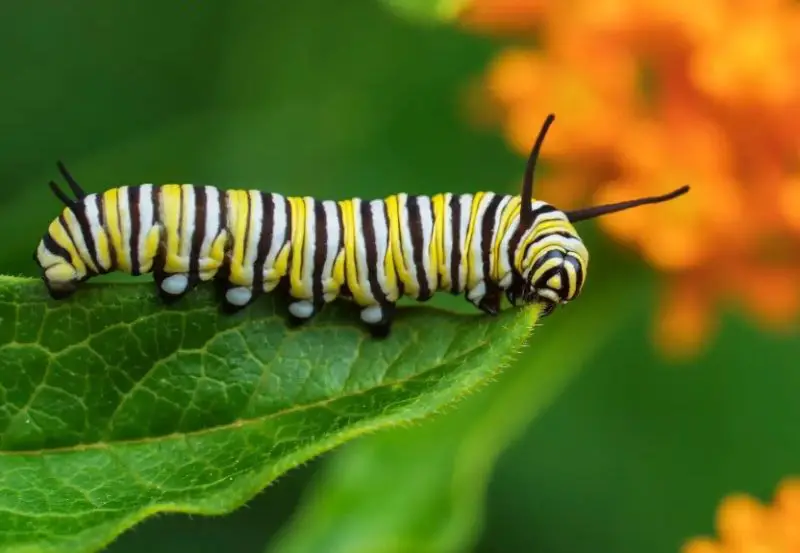
The monarch caterpillar is one of the most recognizable larvae in North America. It features striking yellow, white, and black bands running across its body, which make it easy to identify. These caterpillars grow up to 2 inches long before transforming into a chrysalis, eventually emerging as the iconic orange-and-black monarch butterfly.
When identifying this species, look for two pairs of black, tentacle-like filaments—one near the head and another at the rear. Unlike many other caterpillars, monarchs have a smooth body without spines or hairs, making them distinctive. Their bold coloration is a natural warning signal to predators that they are toxic.
Monarch caterpillars feed exclusively on milkweed plants, which provide the toxic compounds (cardenolides) that protect them from being eaten. Their feeding behavior often leaves milkweed leaves with ragged edges, a common sign of their presence.
In Minnesota, monarch caterpillars are most often seen during summer months in open fields, meadows, and gardens where milkweed grows. They play an important role in the ecosystem, and their presence is celebrated as a symbol of pollinator conservation.
Black Swallowtail Caterpillar (Papilio polyxenes)

The black swallowtail caterpillar is a colorful larva that changes appearance as it grows. Early instars resemble bird droppings, a clever camouflage strategy, but older caterpillars develop bright green bodies with black bands and yellow spots. This transformation helps them blend in with host plants like parsley and dill.
To identify them, look for a plump green caterpillar with alternating black and yellow bands across its body. They also have a special defensive organ called an osmeterium, a bright orange forked structure they extend when threatened, releasing a foul odor to deter predators.
Their feeding behavior is centered around plants in the carrot family, including parsley, fennel, dill, and Queen Anne’s lace. Gardeners often encounter them on herb plants, where they feed voraciously to fuel their transformation into beautiful black swallowtail butterflies.
In Minnesota, black swallowtail caterpillars are found in sunny gardens, meadows, and fields. They thrive in habitats where host plants are abundant, making them common visitors to home gardens that include culinary herbs.
Tiger Swallowtail Caterpillar (Papilio glaucus)
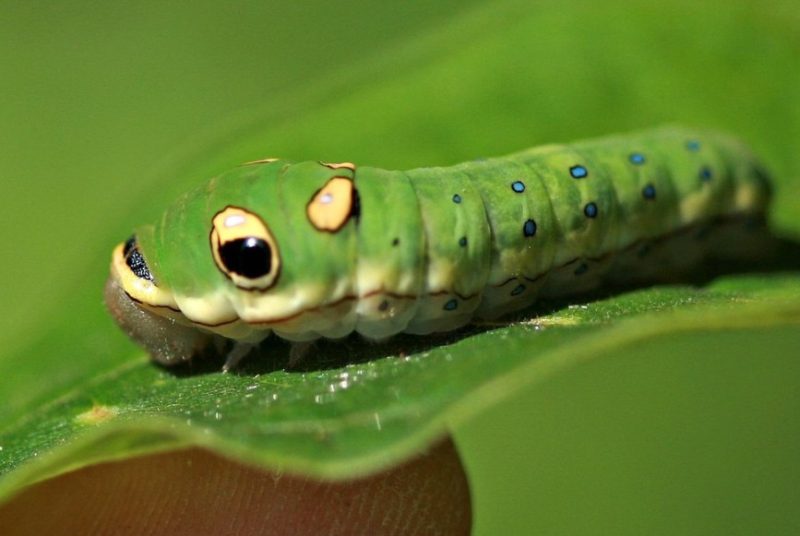
The tiger swallowtail caterpillar is well known for its impressive mimicry. Young caterpillars resemble bird droppings, but as they mature, they turn green with striking eye-like spots near the head. These spots mimic a snake’s eyes, discouraging predators from attacking.
When identifying this caterpillar, look for its large green body, smooth skin, and the dramatic false eye spots on its thorax. Unlike the black swallowtail, it does not have patterned stripes across its body, but its mimicry makes it one of the most unique larvae in Minnesota.
Tiger swallowtail caterpillars feed on a wide variety of host trees, including wild cherry, ash, and birch. They create a silken shelter by folding leaves, where they hide during the day and come out to feed at night.
These caterpillars can be found throughout Minnesota, especially in wooded areas and near rivers where host trees grow. They are essential for maintaining butterfly populations and serve as a great example of nature’s use of camouflage and mimicry.
Cecropia Moth Caterpillar (Hyalophora cecropia)
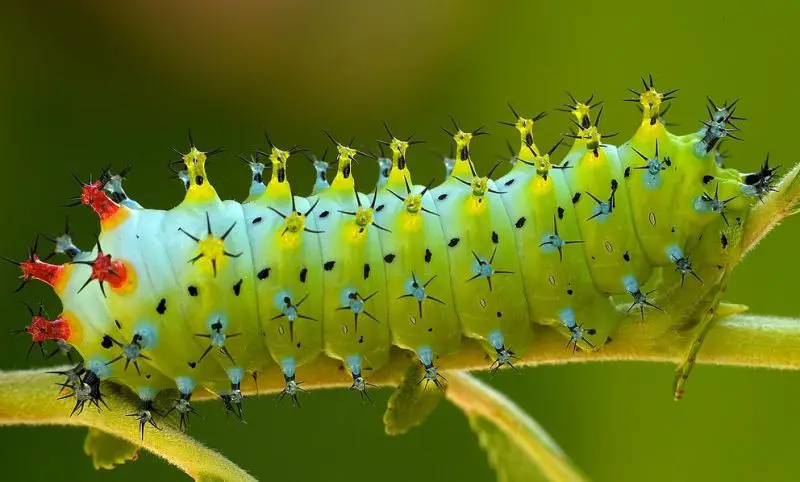
The cecropia moth caterpillar is one of the largest and most spectacular caterpillars in Minnesota. It can reach lengths of up to 4 inches, making it hard to miss. Its body is light green with rows of bright blue, yellow, and red tubercles topped with tiny bristles.
To identify this caterpillar, look for its sheer size and the colorful, bumpy tubercles that cover its body. Unlike spiny or hairy caterpillars, the cecropia has smooth skin with soft nodules, giving it a distinctive appearance compared to other large moth larvae.
These caterpillars feed on the leaves of many tree species, including maple, birch, willow, and cherry. Despite their enormous size and bright colors, they are harmless and rely on their large bulk and unusual look to deter predators.
In Minnesota, cecropia caterpillars are typically found in forests and woodland edges during the summer. They eventually transform into the cecropia moth, the largest moth in North America, with a wingspan of up to 6 inches.
Luna Moth Caterpillar (Actias luna)
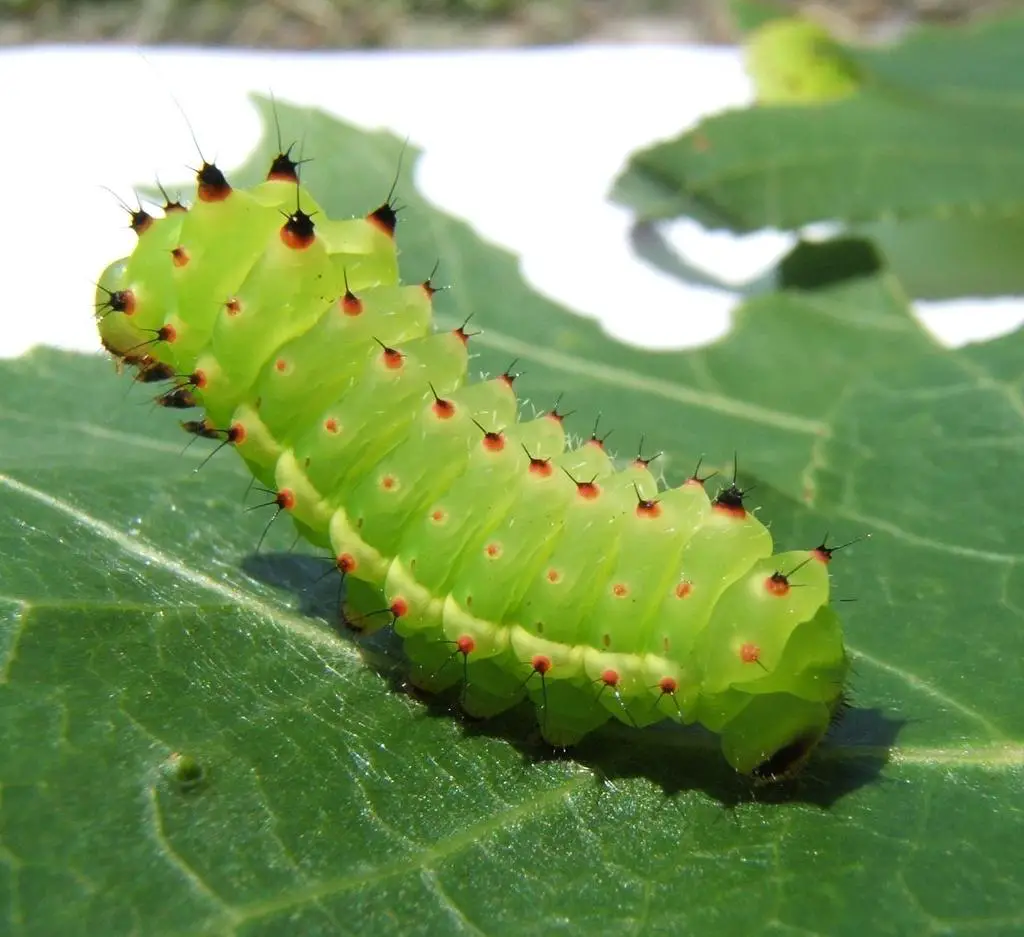
The luna moth caterpillar is another large and eye-catching larva in Minnesota. It has a bright green body covered with fine white hairs and small yellowish lines running lengthwise. Its plump form and translucent green skin give it a glowing appearance under sunlight.
Identifying luna moth caterpillars is straightforward because of their smooth body, bright green coloration, and reddish-orange spots along the sides. They can grow up to 3 inches long and are usually found clinging to leaves where they feed.
They prefer to eat the leaves of hardwood trees such as hickory, walnut, and birch. Unlike hairy caterpillars that may cause irritation, luna moth caterpillars are harmless and peaceful feeders that consume large amounts of foliage.
In Minnesota, luna moth caterpillars are found in wooded habitats, particularly in areas rich with hardwood trees. Their transformation into the stunning luna moth, with pale green wings and long tails, is one of the highlights of the summer moth season.
Polyphemus Moth Caterpillar (Antheraea polyphemus)
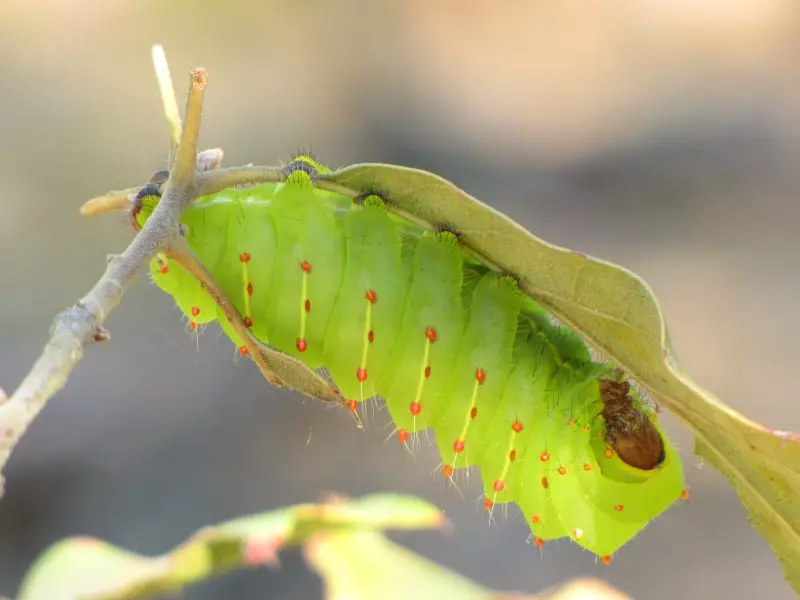
The polyphemus moth caterpillar is among the largest in Minnesota, growing up to 4 inches long. Its bright green body is covered with fine hairs and features yellow stripes running along the sides. This caterpillar’s size and color make it one of the most striking larvae found in the state.
To identify it, look for the large plump body and the silvery spots that decorate its sides. The caterpillar has a smooth appearance, with small reddish bumps that add texture to its otherwise green body. Its impressive size sets it apart from many other local caterpillars.
The polyphemus caterpillar feeds on a wide variety of trees and shrubs, including oak, maple, willow, and birch. Its feeding habits can leave noticeable damage on foliage, but it usually does not appear in large enough numbers to cause serious problems.
In Minnesota, this species inhabits deciduous forests, woodland edges, and even suburban areas where host trees grow. Eventually, it develops into the polyphemus moth, a giant silk moth with a wingspan of up to 6 inches and large eye-like markings on its hindwings.
Isabella Tiger Moth Caterpillar (Woolly Bear) (Pyrrharctia isabella)
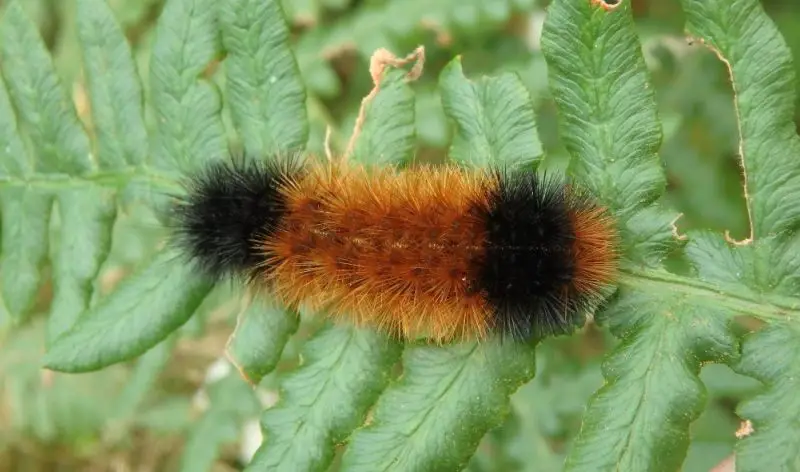
The woolly bear caterpillar is one of the most familiar caterpillars to Minnesotans. It has a fuzzy body divided into black bands at both ends and a reddish-brown band in the middle. This distinctive pattern makes it easy to recognize.
Identification is simple due to its bristly coat of hairs, known as setae, which give it a woolly appearance. Despite looking prickly, these hairs are not dangerous, though they may cause mild skin irritation for sensitive individuals.
Woolly bears feed on a variety of low-growing plants such as dandelions, clovers, and grasses. Their broad diet allows them to thrive in many different habitats, including gardens, fields, and roadsides.
In Minnesota, these caterpillars are most visible in autumn when they wander across roads and yards searching for a place to hibernate. They are famous for the folklore suggesting that the width of their brown band predicts the severity of the coming winter.
White-marked Tussock Moth Caterpillar (Orgyia leucostigma)
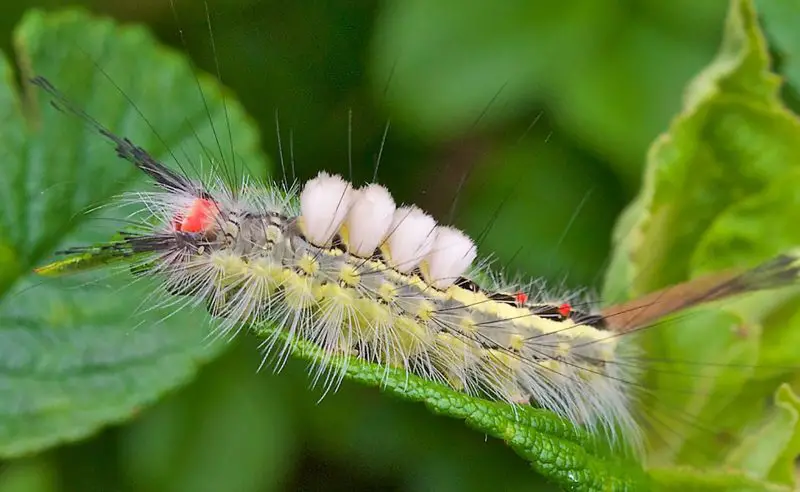
The white-marked tussock moth caterpillar is a colorful and spiky species often seen in summer. It has a gray to black body decorated with yellow stripes, red spots, and tufts of white hair along its back. Four distinctive white toothbrush-like tufts on its back are its key feature.
When identifying this species, look for the long black pencil-like tufts of hair at both ends of the body. These caterpillars are highly distinctive, with their flamboyant mix of colors and tufts unlike any other common species in Minnesota.
They feed on the leaves of many tree species, including oak, birch, elm, and apple. In large numbers, they can cause noticeable defoliation, though outbreaks tend to be temporary.
In Minnesota, these caterpillars are often spotted in suburban yards, parks, and forested areas. While their hairs may irritate skin, they are not highly dangerous. Eventually, they become small grayish moths with short lifespans.
Eastern Tent Caterpillar (Malacosoma americanum)
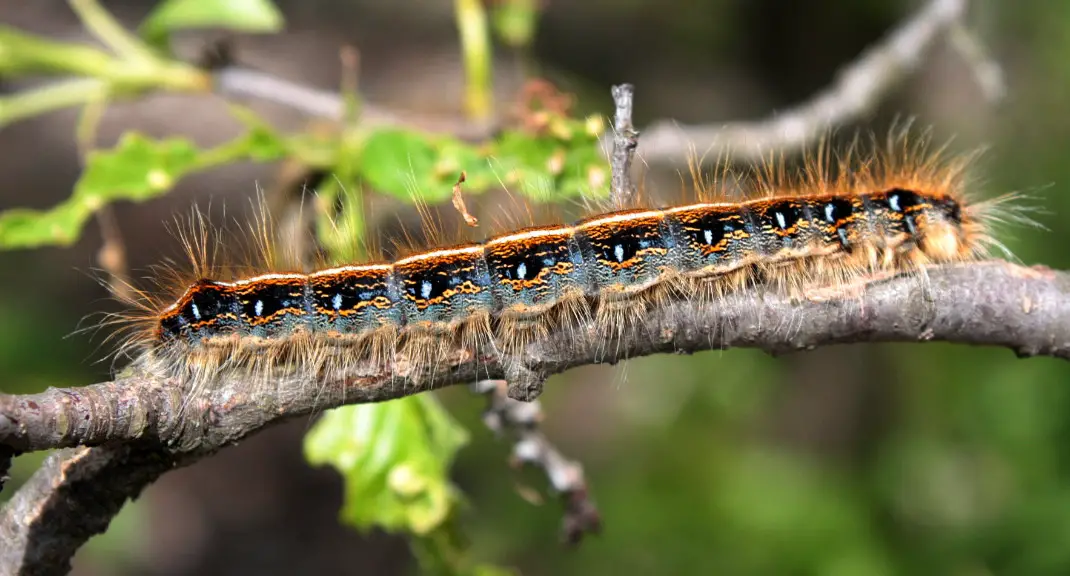
The eastern tent caterpillar is well known for its habit of building silken nests in the forks of tree branches. These caterpillars are dark-colored with a white stripe down the center of their backs, accompanied by blue and black markings along the sides.
To identify them, look for their communal silk tents, which are most commonly found in cherry and apple trees. The caterpillars themselves have hairy bodies and are often seen moving in groups.
Their behavior is highly social, with caterpillars working together to expand their silken nests and foraging collectively. They feed mainly on cherry, apple, and other fruit trees, sometimes causing significant defoliation.
In Minnesota, eastern tent caterpillars are typically seen in spring and early summer. While their tents may appear unsightly, they rarely cause long-term damage to trees, as most host plants recover after defoliation.
Forest Tent Caterpillar (Malacosoma disstria)
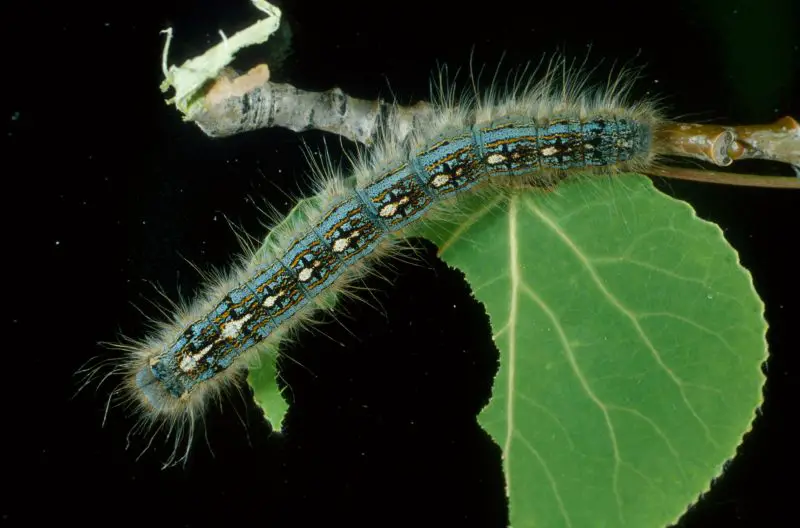
The forest tent caterpillar is a close relative of the eastern tent caterpillar, but it does not build tents. Instead, it forms silken mats on tree trunks where groups of caterpillars gather. Its body is bluish with black bands and features a series of white, footprint-shaped spots down its back.
When identifying this species, look for the unique white spots and the bluish hue of its body. Unlike the eastern tent caterpillar’s solid white stripe, the forest tent caterpillar’s markings are broken into footprints.
They feed on a wide variety of hardwood trees, especially aspen, oak, and maple. During population outbreaks, they can strip vast areas of forest, sometimes causing concern among landowners and foresters.
In Minnesota, forest tent caterpillars are cyclical pests, with outbreaks occurring every 10–15 years. Despite their defoliation, most trees survive and regrow their leaves later in the season, making them more of a nuisance than a long-term threat.
Yellow Woolly Bear (Spilosoma virginica)
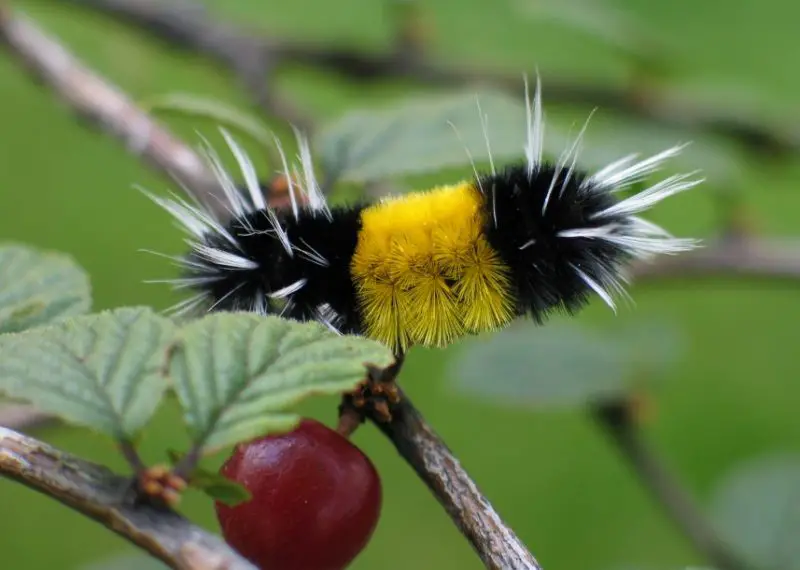
The yellow woolly bear caterpillar is the larval stage of the Virginia tiger moth. It is covered in dense bristles that range from yellow to orange or sometimes nearly white. This fuzzy caterpillar can vary in color, but its soft and woolly appearance makes it recognizable.
When identifying this species, look for a caterpillar with long, evenly distributed bristles and a pale yellow to golden body underneath. Unlike the black-and-brown Isabella woolly bear, this species tends to be lighter in color overall.
Yellow woolly bears feed on a wide range of plants, including dandelions, clover, grasses, and various garden crops. Because of their varied diet, they adapt well to both wild habitats and residential areas.
In Minnesota, these caterpillars are often seen in late summer and fall, crawling across lawns, gardens, and fields. They eventually transform into Virginia tiger moths, which are delicate white moths with small black spots on their wings.
Io Moth Caterpillar (Automeris io)
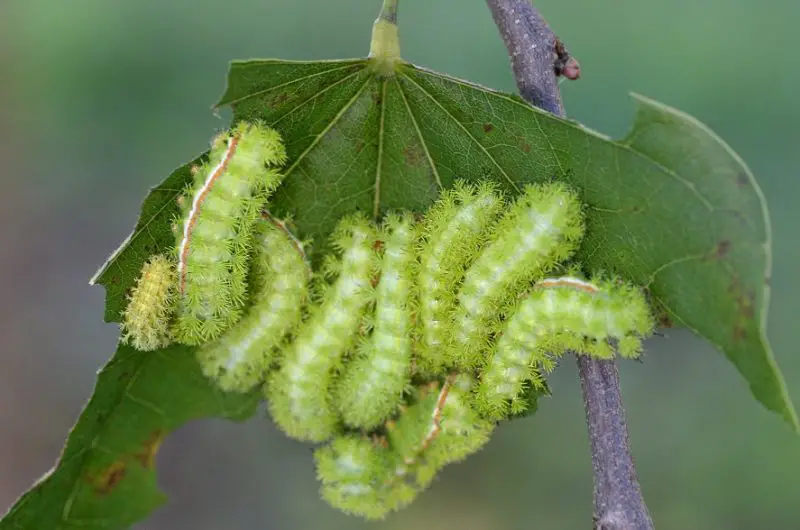
The io moth caterpillar is a striking species, bright green with red and white stripes running lengthwise along its sides. What makes this caterpillar particularly memorable is its covering of sharp, branched spines that can deliver a painful sting.
To identify it, look for the vibrant green body decorated with fine stripes and dense clusters of spiny bristles. These spines serve as a defense mechanism, deterring predators and warning people to avoid handling them.
Io caterpillars feed on a wide range of host plants, including willow, hackberry, elm, and various fruit trees. Their appetite for diverse foliage makes them common in both forested areas and suburban landscapes.
In Minnesota, they are typically spotted in late summer. After pupation, they emerge as io moths, which are famous for their hindwings that display large, dramatic eyespots used to scare away predators.
American Dagger Moth Caterpillar (Acronicta americana)
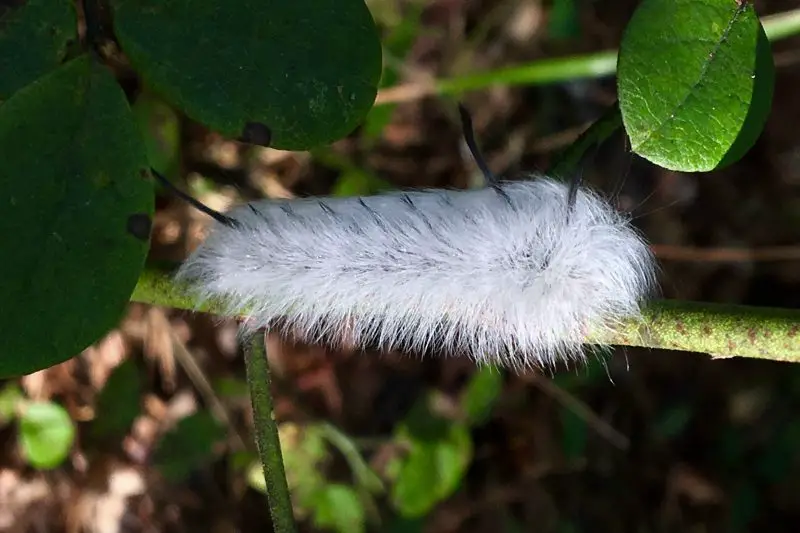
The American dagger moth caterpillar is a fuzzy yellow caterpillar with long black hair-like tufts extending from its body. Its bright coloration serves as a warning, as its hairs can cause skin irritation if touched.
Identification is easy due to its lemon-yellow body, covered in long, silky hairs with distinctive black tufts that project outward. These black tufts are the main feature that distinguishes it from other woolly or fuzzy caterpillars.
This species feeds on the leaves of many deciduous trees, such as oak, maple, and birch. They are commonly found in wooded areas where their preferred food sources are abundant.
In Minnesota, American dagger caterpillars appear in late summer and early fall. While beautiful to look at, they should be admired without direct contact, as their irritating hairs are a mild defense mechanism against predators.
Milkweed Tussock Moth Caterpillar (Euchaetes egle)
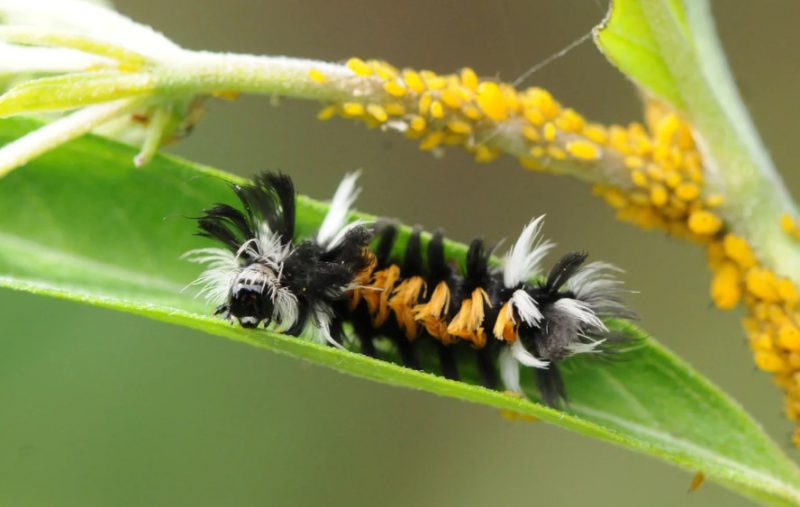
The milkweed tussock moth caterpillar is one of the most colorful caterpillars in Minnesota. It has tufts of black, orange, and white hairs arranged in striking patterns along its body. This flashy coloration serves as a warning to predators.
For identification, look for the bold mix of black and orange tufts with interspersed white patches. Their fuzzy appearance and clumped hair tufts make them stand out compared to smooth-bodied caterpillars like monarchs.
As their name suggests, these caterpillars feed primarily on milkweed. Like monarch caterpillars, they absorb toxic compounds from the plant, which make them unpalatable to birds and other predators.
In Minnesota, they are commonly seen in midsummer on milkweed patches in meadows, fields, and roadsides. Their transformation leads to the milkweed tussock moth, a gray moth that contrasts with the caterpillar’s brilliant appearance.
Spicebush Swallowtail Caterpillar (Papilio troilus)
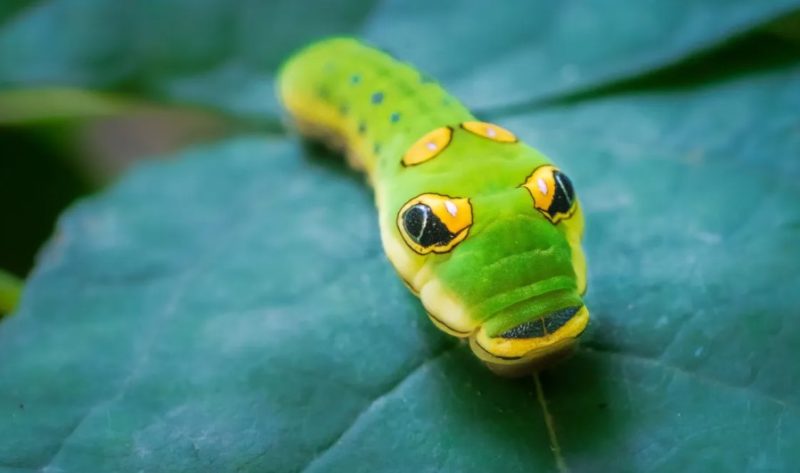
The spicebush swallowtail caterpillar is famous for its impressive mimicry. Younger larvae resemble bird droppings, but older ones turn bright green with large, false eye spots near the head. These markings make them look like small snakes, deterring predators.
To identify this caterpillar, look for its smooth green body and oversized, cartoon-like eye spots that are located on the thorax. These false eyes give the caterpillar a defensive advantage, making predators hesitate before attacking.
Spicebush swallowtail caterpillars feed mainly on spicebush and sassafras, though in Minnesota they may also feed on other related plants. They often rest inside folded leaves, held together by silk, which provide protection during the day.
In Minnesota, they are mostly found in wooded areas and near wetlands where host plants grow. Their transformation results in one of the most beautiful swallowtail butterflies, marked by shimmering blue and green coloration.
Great Spangled Fritillary Caterpillar (Speyeria cybele)
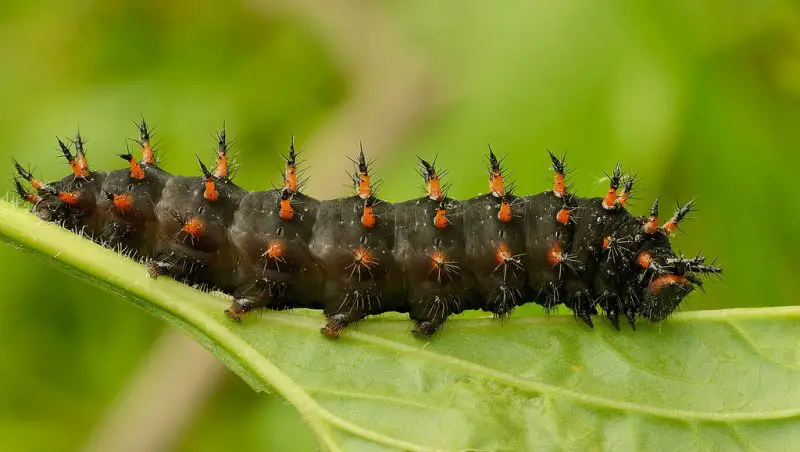
The great spangled fritillary caterpillar is a dark, spiny larva that contrasts strongly with the bright orange butterfly it becomes. Its body is mostly black or dark brown with rows of branching spines, giving it a prickly appearance. Despite its threatening look, it is harmless to people.
When identifying this caterpillar, look for its black body with lighter spots or stripes along the sides. The spiny projections covering its body are a key feature that makes it stand out from smooth-bodied caterpillars.
This species feeds primarily on violets, which are its main host plants. The female butterfly lays eggs near violet patches in late summer, and the tiny caterpillars hatch but do not feed until spring, when fresh violet leaves become available.
In Minnesota, great spangled fritillary caterpillars are usually found in meadows, prairies, and open woodlands where violets grow. They are nocturnal feeders, hiding during the day and emerging at night to feed on their host plants.
Viceroy Caterpillar (Limenitis archippus)
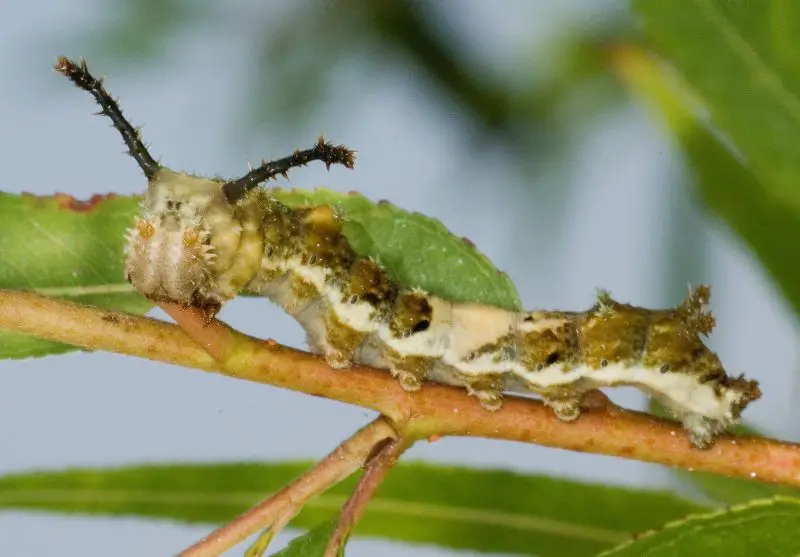
The viceroy caterpillar is a master of disguise. Instead of relying on bright colors, it mimics bird droppings to avoid detection. Its body is mottled brown and green, with small spines and a humped shape near the middle, making it blend seamlessly with twigs and leaves.
To identify this species, look for its unusual shape and coloration that resemble waste material. It also has a distinctive head with small knobs that add to its disguise. Unlike monarch caterpillars, which are boldly striped, the viceroy is camouflaged and inconspicuous.
Viceroy caterpillars feed primarily on willow and poplar trees. They often build shelters by folding or tying leaves with silk, hiding inside during the day and coming out to feed in safety.
In Minnesota, they are found near wetlands, rivers, and lowlands where host trees are abundant. Their clever camouflage helps them survive until they transform into the viceroy butterfly, which closely mimics the monarch in appearance.
Mourning Cloak Caterpillar (Nymphalis antiopa)

The mourning cloak caterpillar is dark and spiny, with a black body decorated by rows of white speckles and a line of bright red spots along its back. Its body is covered with sharp black spines that make it appear dangerous, though it is harmless to touch.
Identification is simple thanks to the combination of black coloration, red dorsal spots, and bristly spines. Unlike woolly bear caterpillars, which are fuzzy all over, the mourning cloak has more rigid and spiky hairs.
These caterpillars feed on willow, elm, cottonwood, and birch. They are social feeders and can often be seen in groups, stripping branches of leaves before moving to another location together.
In Minnesota, mourning cloak caterpillars are common in woodlands, riverbanks, and parks. Their transformation leads to the mourning cloak butterfly, one of the earliest butterflies to appear in spring, often seen flying before snow has fully melted.
Red-spotted Purple Caterpillar (Limenitis arthemis)
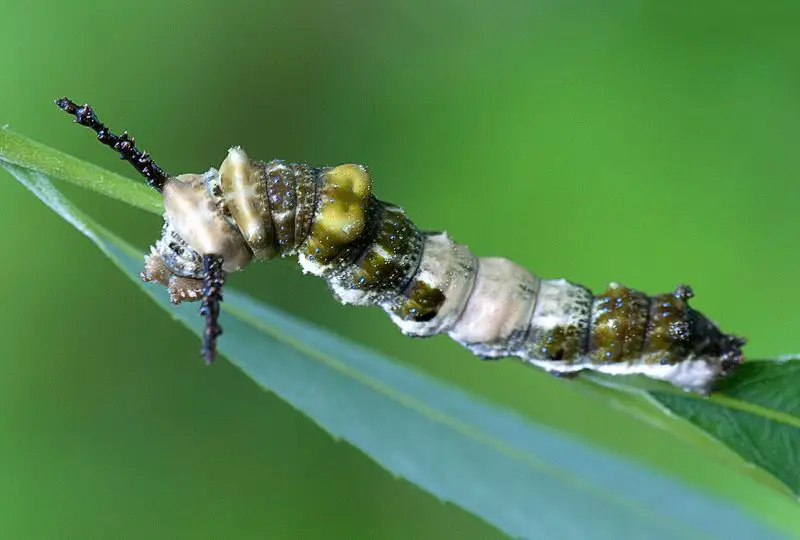
The red-spotted purple caterpillar has a highly unusual appearance. It is brown with white markings, giving it the look of a bird dropping—an effective camouflage against predators. Its body also has small, spiky projections near the head that enhance its disguise.
When identifying this species, look for the uneven, knobby shape of its body and the contrasting white blotches across its back. The mimicry makes it very difficult to spot when resting on branches.
Its diet includes cherry, birch, willow, and poplar trees. Like other Limenitis species, it often creates shelters from leaves tied together with silk, which provide cover from predators.
In Minnesota, red-spotted purple caterpillars are found in forests, wooded edges, and near streams where host plants grow. They eventually transform into one of the state’s most beautiful butterflies, with deep blue iridescent wings accented by red-orange spots.
Hackberry Emperor Caterpillar (Asterocampa celtis)
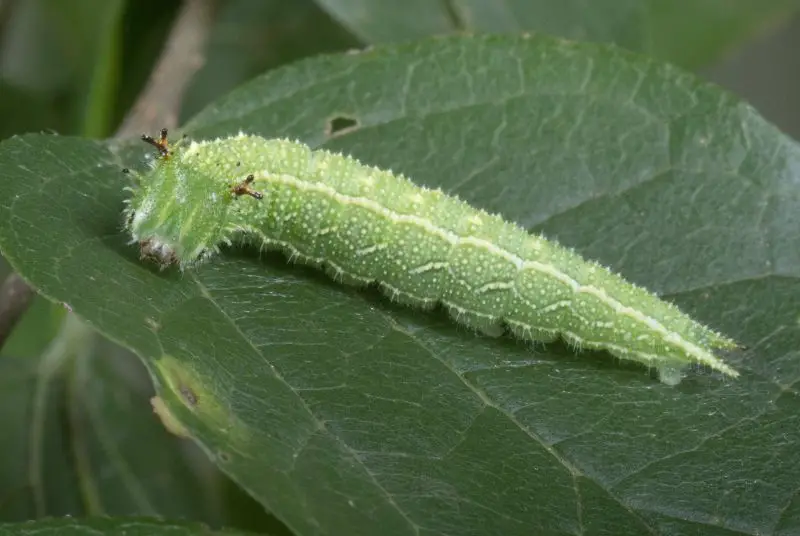
The hackberry emperor caterpillar is a green larva with small yellowish stripes and two tiny horn-like projections at the front of its head. Its body is smooth and blends well with the leaves of its host plant, making it difficult to spot.
For identification, look for its pale green coloration, thin yellow lines running lengthwise, and the two short, stubby horns on its head. These features set it apart from more common green caterpillars like swallowtails.
As its name suggests, this species feeds exclusively on hackberry trees. The caterpillars rest along the midribs of leaves, where their green bodies make them nearly invisible to predators.
In Minnesota, hackberry emperor caterpillars are most often found in areas where hackberry trees grow, such as woodlands, parks, and river valleys. After pupation, they become fast-flying butterflies that are often seen darting around sunny openings.
Conclusion
Caterpillars in Minnesota are far more than just the larval stage of butterflies and moths. They play a critical role in the food chain, support bird populations, and serve as important indicators of ecosystem health. From the bold stripes of the monarch caterpillar to the clever camouflage of the viceroy, each species brings its own story to the landscape.
By recognizing and appreciating these 20 types of caterpillars, you can gain insight into the delicate balance of Minnesota’s natural world. Whether in a forest, prairie, or backyard garden, spotting these unique creatures is a reminder of the beauty and diversity thriving across the state.
FAQs about Caterpillars in Minnesota
What time of year can you see caterpillars in Minnesota?
Caterpillars in Minnesota are most active from late spring through early fall. Many species, such as monarchs and swallowtails, appear in summer when host plants are abundant. Some, like woolly bears, are most visible in autumn as they search for a place to hibernate.
Are caterpillars in Minnesota dangerous to touch?
Most caterpillars in Minnesota are harmless, but a few species like the American dagger moth caterpillar and io moth caterpillar have irritating hairs or spines. These can cause mild skin reactions, so it’s best to admire caterpillars without handling them.
What do caterpillars in Minnesota eat?
Different species feed on specific host plants. For example, monarch caterpillars eat only milkweed, while black swallowtail caterpillars feed on parsley, dill, and related plants. Others, like the polyphemus and cecropia moth caterpillars, feed on a wide variety of trees.
Where can you find caterpillars in Minnesota?
Caterpillars can be found in forests, meadows, gardens, and along riverbanks. They are often seen on the leaves of host plants such as milkweed, willow, hackberry, and fruit trees. Gardeners frequently encounter swallowtail caterpillars on herbs and vegetables.
Do all caterpillars in Minnesota turn into butterflies?
Not all caterpillars become butterflies. Many species, such as the cecropia moth, luna moth, and polyphemus moth caterpillars, transform into large silk moths. Others, like monarch and swallowtail caterpillars, develop into butterflies. Both moths and butterflies play key roles in the ecosystem.


